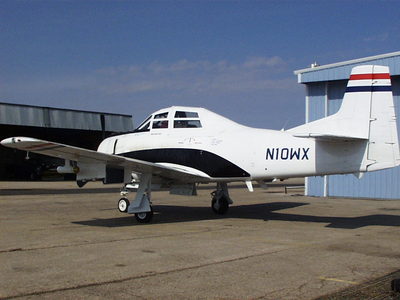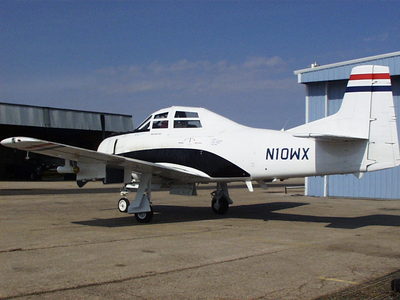Armored T-28 Research Aircraft Facility
Development and History
 |
The original concept of a meteorological research aircraft capable of penetrating hailstorms was developed and promoted by Paul MacCready beginning in the late 1950's. At the time, this was widely regarded as not feasible. The hail researchers who had been developing a hail suppression program in the Soviet Union considered storm penetrations by an aircraft as too dangerous. They did not send research or seeding aircraft into hailstorms. Instead, they relied on rockets and artillery shells to deliver their seeding materials into what they thought would be appropriate locations in the storms. Within the American research community, the mainstream thought was similar to that of the Soviets; namely, that penetrations of hailstorms by manned aircraft were too dangerous.
The idea of developing a storm penetration aircraft persisted, however, and began to approach reality following Project Hailswath in 1966, when the National Science Foundation provided funds to support a detailed investigation. MacCready commissioned an associate, Robin Williamson, to do the aircraft feasibility study.
Williamson considered all aircraft in the military and civilian fleet of the Vietnam war era. All aspects of aircraft operation including survivability, maintainability, costs, and performance were analyzed. Strictly on the basis of performance characteristics, he concluded that the best aircraft for hailstorm penetrations would be a Douglas "Dauntless" dive bomber, a World War II era combat aircraft. His second choice was a T-28 military trainer, developed in the late 1940's as a high-performance, prop-driven, pre-jet trainer. When costs and maintainability were factored in, however, the T-28 was judged to be the overall top choice.
Some of the prime deciding factors in Williamson's study were:
- Aircraft equipped with reciprocating engines were better suited to severe-storm penetrations than those equipped with jet engines, being less susceptible to hail and ice damage.
- Twin-engine aircraft were not superior to single-engine aircraft. Williamson's philosophy was that if the environment is so severe that one engine goes out, the second will soon be lost, too.
- No existing airframe was designed to survive impacts of more than 3/4 inch hail, so any aircraft chosen would require additional armoring. The lower speed of prop-driven aircraft meant that thinner metal plating would be required on the leading edges of the aircraft to survive hail impacts. The added armor that would be required on faster jet aircraft countered the advantage of their higher-performance powerplants.
- De-icing capabilities were not considered critical because very high supercooled liquid water concentrations were expected and it would be impossible to de-ice completely anyway. Williamson was more concerned with wind shear and turbulence than icing.
- While the Dauntless had more power and a stronger airframe (it could stand 12-g accelerations), the T-28 was adequate for penetrating the anticipated turbulence and strong shear.
- At the time, T-28's were much more plentiful than Dauntless dive bombers, and T-28 parts were readily available in the supply pipeline.
Using the results of Williamson's study, MacCready successfully presented his idea to the National Science Foundation (NSF) in 1967. MacCready's company, Meteorology Research, Incorporated, under contract to the Institute of Atmospheric Sciences' NSF-funded Hailstorm Models Project, acquired and registered a T-28. Williamson Aircraft Co. (headed by Robin Williamson) contracted to outfit the aircraft for hailstorm penetrations. This work began in 1968 and was carried on through 1969. The basic modifications to the aircraft are discussed here and in Sand and Schleusener (1974).
After the modifications were complete, the T-28 was capable of performing hailstorm penetrations to altitudes up to about 25,000 ft (7.6 km) and was able to withstand impacts of hailstones up to 7.5 cm in diameter at 100 m/s relative speed with minimal damage. Some meteorological instrumentation was installed and the aircraft made some test flights during the summer of 1969 at Rapid City, South Dakota, and Flagstaff, Arizona, for the primary purpose of determining its capacity for carrying heavy loads of structural ice. It was found that the aircraft could handle up to an inch of ice with only a relatively small increase in speed to maintain controllability. Since the T-28 was to be used in summer thunderstorms where a layer of warm air would be present between icing zones and the ground, icing was not felt to be a major problem.
At this time, ownership of the T-28 passed to the Institute of Atmospheric Sciences at the South Dakota School of Mines and Technology. The Institute's Director, Dr. Richard Schleusener, was a leading figure in the U.S. hail research effort at that time and had actively supported MacCready's concept of an armored aircraft for hailstorm penetrations.
In 1969, a military technical order (TO) revealed that the aircraft needed strengthening of the wing main spar to keep it airworthy. This order came as a result of extensive military experience with T-28 aircraft, including some wing failures during high-g aerobatic maneuvers. The T-28 was therefore sent to the Naval Air Rework Facility at Pensacola, Florida, for wing spar strengthening.
The T-28 returned to active duty in time to make a few cloud penetrations prior to the end of the 1970 hail season in Colorado. These operations with the Joint Hail Research Project proved the viability of the T-28 as a thunderstorm research platform. Fifteen cloud penetrations into increasingly larger storms were made to build confidence in the system.
Engine problems and other experiences in 1971 led to the conclusion that the T-28 required a significant change in the engine and an updating of the basic aircraft. As a result, in 1972 the aircraft was sent back to the Naval Air Rework Facility at Pensacola, Florida, to be upgraded with extensive airframe updating and installation of a more state-of-the-art engine (R-1820-86A) and a stronger propeller. These changes increased engine power from 1200 to 1425 horsepower. After the Naval Air Rework Facility accomplished these changes, the T-28 was in outstanding mechanical condition. It made nearly 200 research flights from 1972 through 1976 in support of the National Hail Research Experiment (NHRE) without further modifications. Then, structural strengthening in the tail section was accomplished by the Naval Air Rework Facility in 1977 in response to another TO.
Two more successful field seasons, involving thunderstorm studies in Colorado, Florida, and Oklahoma, followed in 1978 and 1979 before a mishap on a slippery runway necessitated replacement of the engine and propeller in 1980. The replacement engine was identical to the damaged one. However, the replacement propeller was a shortened model used for carrier-based aircraft; this resulted in an estimated 15% increase in rate of fuel consumption with a corresponding decrease of ~15 min in flight duration but no significant loss in other performance characteristics.
The T-28 participated in summer field programs almost every year from 1972 through 2003. Overhauls of the last engine in 1981 and 1982 left the T-28 in good operational condition through the end of its field season in 2000. Another long-blade propeller was located in 1987 and was installed on the aircraft to return its endurance to the former levels. An engine failure in 2000 resulted in installation of a new engine that served for 4 additional projects in the summers of 2001-2003. At the end of 2003 the aircraft was retired from service.
References
Sand, W.R. and R.A. Schleusener, 1974: development of an armored T-28 aircraft for probing hailstorms. Bull. Amer. Meteor. Soc., 55, 1115–1122, https://doi.org/10.1175/1520-0477(1974)055<1115:DOAATA>2.0.CO;2
